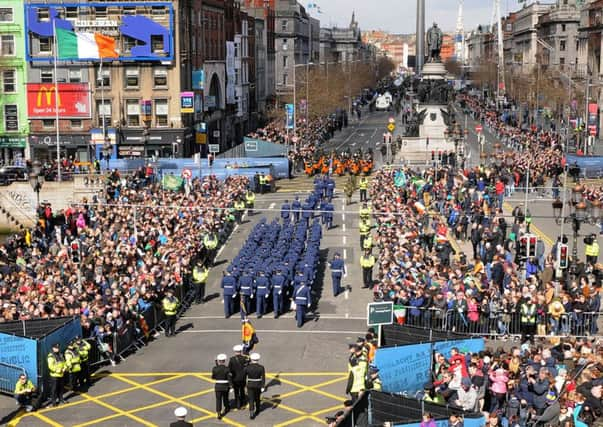Population of the island of Ireland is now 6.6 million


The assessment of people and their lifestyles south of the border was taken on Sunday April 24.
The findings mean that the population of the island of Ireland is now around 6.6 million.
Advertisement
Hide AdAdvertisement
Hide AdNorthern Ireland’s population was found to be 1.81 million in the 2011 census and is estimated to have risen by around 50,000 people since then.
When added to the Republic’s population total, the overall number of people living on the whole island is continuing to edge its way back toward the all-time high of over eight million people in 1840, before the famine wreaked havoc, causing deaths and mass emigration.
At its lowest point, in the middle of the 20th century, the population of the Republic was 2.9 million and the whole island only had a population of around 4.3 million people.
The newly released Census 2016 in the Republic found only three of the 26 counties experienced a fall in populations – with Donegal down by 2,382, the most significant fall as it suffers some of the worst emigration trends.
Advertisement
Hide AdAdvertisement
Hide AdThe population grew by 169,724 since 2011, an average of almost 34,000 a year, the report from the Central Statistics Office (CSO) showed.
The fastest-growing areas were Greater Dublin, along with the commuter belts of Meath, Kildare and Laois and the cities of Cork and Galway.
The CSO said Donegal’s population fell by 1.5%, the largest measured drop in 2016, while Mayo and Sligo saw populations decrease less significantly by 231 and 36 respectively.
The fastest population growth over the last five years has been in the north Dublin area classed as Fingal, where there has been an 8.1% increase.
Advertisement
Hide AdAdvertisement
Hide AdOther regions which topped 5% growth include Dun Laoghaire-Rathdown on the south side of the capital, Meath, Kildare, Cork and Galway cities, South Dublin and Laois.
The CSO estimated that net migration was minus 28,558, but it warned the number should be treated with caution until further analysis is done on the number of visitors to Ireland on Census night and Irish residents abroad at the time.
But it said the areas worst-hit by emigration were Donegal, Mayo, Co Galway and Limerick and South Dublin.
Census 2016’s preliminary results also revealed a continued fall in the sex ratio trend as there are now 978 men for every 1,000 women.
Advertisement
Hide AdAdvertisement
Hide AdHousing is a big factor in the first batch of results released by the CSO and it recorded almost 200,000 empty homes, not counting holiday homes and people temporarily away from the properties.
Carlow experienced the largest fall in the number of vacant dwellings from 3,202 in 2011 to 2,417 in 2016.
Leitrim had the highest rate in 2011 and it has fallen by 3.7% in the last five years while Donegal, which had a rate of 28.4% in 2011, had a fall of less than 1% over the same period, although a large proportion of these properties will be holiday homes.
The CSO said its enumerators classed homes as “vacant dwellings” after several visits and if there were no signs of life, no furniture, no parked cars, junk mail accumulating, overgrown garden and so on.
Advertisement
Hide AdAdvertisement
Hide AdIt said they also spoke to neighbours to inquire if the property was lying empty and not used.
The CSO said it did not count half-finished homes, incomplete properties in ghost estates or derelict buildings as vacant.
Census 2016 was the 27th in Ireland.
The first was carried out in 1821 and was followed by revised counts every 10 years up to 1946, bar the years from 1911 to 1926, before they were held every five years from 1951.
Homeless and housing charity Peter McVerry Trust called for urgent action over the vast numbers of empty homes.
Advertisement
Hide AdAdvertisement
Hide AdSpokesman Francis Doherty said the 198,358 vacant properties was unacceptably high.
“The level of vacant housing units underlines just how dysfunctional our housing system has become. In Dublin, we have around 4,000 individuals in homelessness yet the figures out today show over 36,000 vacant units across the region,” he said.
The trust called for compulsory purchase orders to take the unused buildings out of private ownership and real-time monitoring of whether houses are being filled.
“We should not tolerate a situation where there are thousands of homes lying idle, particularly during a housing and homeless emergency,” Mr Doherty said.
Advertisement
Hide AdAdvertisement
Hide AdThe preliminary figures on population also showed that the country should have more politicians.
The CSO said the number of people in the country for each of the 158 TDs in the Dail is now 30,114 but the constitutional limit is 30,000.
It said its analysis of the number showed 25 constituencies are now over the limit of people per TD with the biggest discrepancies in Dublin North West with 32,299 per Dail representative, Dublin Central with 32,016 and Dublin Rathdown at 31,375.